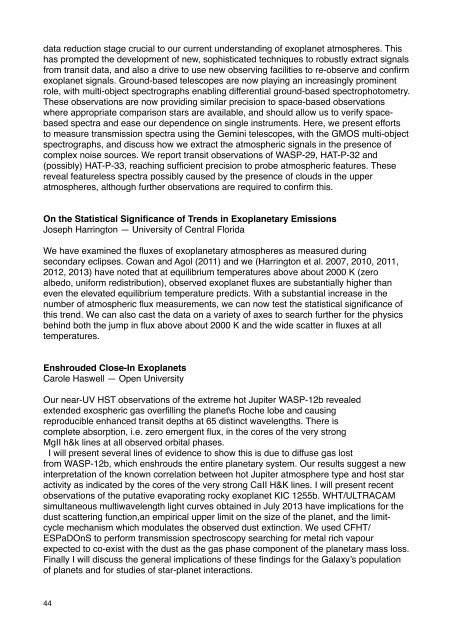Exoclimes_Conference_booklet1
Exoclimes_Conference_booklet1
Exoclimes_Conference_booklet1
You also want an ePaper? Increase the reach of your titles
YUMPU automatically turns print PDFs into web optimized ePapers that Google loves.
data reduction stage crucial to our current understanding of exoplanet atmospheres. This<br />
has prompted the development of new, sophisticated techniques to robustly extract signals<br />
from transit data, and also a drive to use new observing facilities to re-observe and confirm<br />
exoplanet signals. Ground-based telescopes are now playing an increasingly prominent<br />
role, with multi-object spectrographs enabling differential ground-based spectrophotometry.<br />
These observations are now providing similar precision to space-based observations<br />
where appropriate comparison stars are available, and should allow us to verify spacebased<br />
spectra and ease our dependence on single instruments. Here, we present efforts<br />
to measure transmission spectra using the Gemini telescopes, with the GMOS multi-object<br />
spectrographs, and discuss how we extract the atmospheric signals in the presence of<br />
complex noise sources. We report transit observations of WASP-29, HAT-P-32 and<br />
(possibly) HAT-P-33, reaching sufficient precision to probe atmospheric features. These<br />
reveal featureless spectra possibly caused by the presence of clouds in the upper<br />
atmospheres, although further observations are required to confirm this.<br />
On the Statistical Significance of Trends in Exoplanetary Emissions!<br />
Joseph Harrington — University of Central Florida<br />
We have examined the fluxes of exoplanetary atmospheres as measured during<br />
secondary eclipses. Cowan and Agol (2011) and we (Harrington et al. 2007, 2010, 2011,<br />
2012, 2013) have noted that at equilibrium temperatures above about 2000 K (zero<br />
albedo, uniform redistribution), observed exoplanet fluxes are substantially higher than<br />
even the elevated equilibrium temperature predicts. With a substantial increase in the<br />
number of atmospheric flux measurements, we can now test the statistical significance of<br />
this trend. We can also cast the data on a variety of axes to search further for the physics<br />
behind both the jump in flux above about 2000 K and the wide scatter in fluxes at all<br />
temperatures.<br />
Enshrouded Close-In Exoplanets<br />
Carole Haswell — Open University<br />
Our near-UV HST observations of the extreme hot Jupiter WASP-12b revealed<br />
extended exospheric gas overfilling the planet\s Roche lobe and causing<br />
reproducible enhanced transit depths at 65 distinct wavelengths. There is<br />
complete absorption, i.e. zero emergent flux, in the cores of the very strong<br />
MgII h&k lines at all observed orbital phases.<br />
I will present several lines of evidence to show this is due to diffuse gas lost<br />
from WASP-12b, which enshrouds the entire planetary system. Our results suggest a new<br />
interpretation of the known correlation between hot Jupiter atmosphere type and host star<br />
activity as indicated by the cores of the very strong CaII H&K lines. I will present recent<br />
observations of the putative evaporating rocky exoplanet KIC 1255b. WHT/ULTRACAM<br />
simultaneous multiwavelength light curves obtained in July 2013 have implications for the<br />
dust scattering function,an empirical upper limit on the size of the planet, and the limitcycle<br />
mechanism which modulates the observed dust extinction. We used CFHT/<br />
ESPaDOnS to perform transmission spectroscopy searching for metal rich vapour<br />
expected to co-exist with the dust as the gas phase component of the planetary mass loss.<br />
Finally I will discuss the general implications of these findings for the Galaxy’s population<br />
of planets and for studies of star-planet interactions.<br />
44


